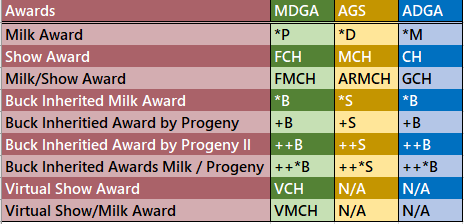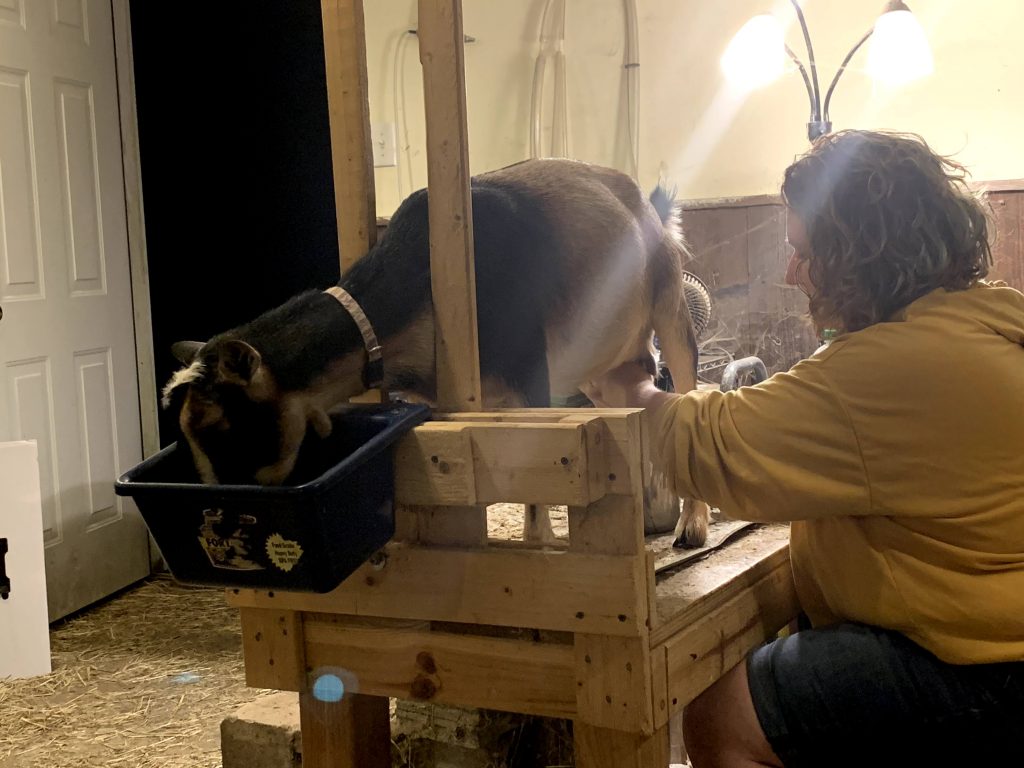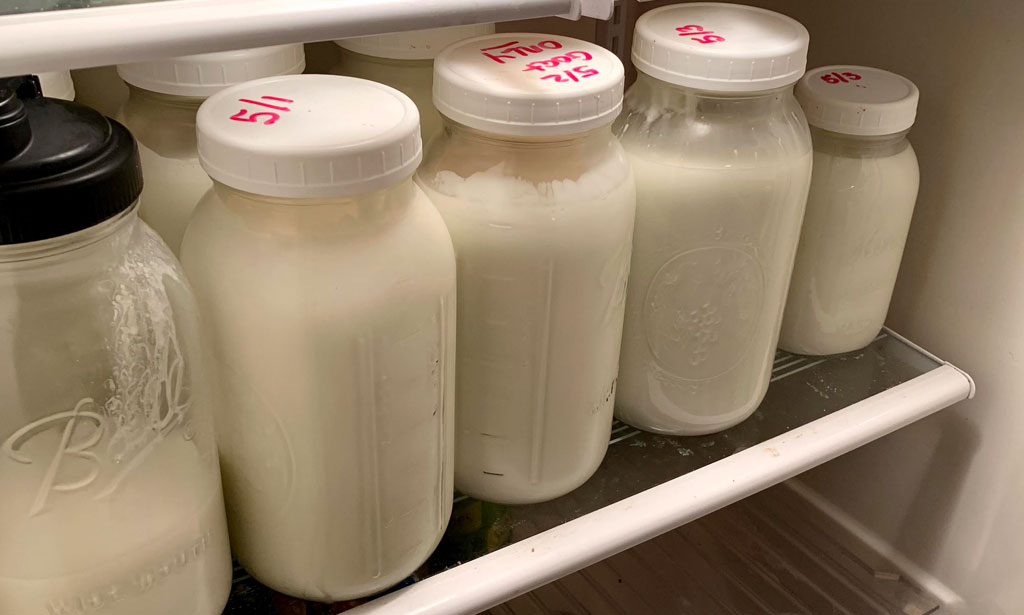If you’ve been browsing dairy goat pedigrees (please tell me I’m not the only person who does this?), you may have seen abbreviations like *M or 2*M for does or *B, +B, or ++B for bucks registered with the ADGA. These designations give an indication of the type of milk production you might expect from that animal or its progeny. If you’re looking to have a strong dairy herd, it’s important to understand these abbreviations when bringing in new stock, making breeding decisions, and determining which kids to retain or sell to performance-testing herds.
Different Designations for Different Registries
The AGS has equivalent designations using different letters – “D” for does (instead of “M”), and “S” for bucks (instead of “B”). The MDGA uses “P” for does, and, like the ADGA, uses “B” for bucks. This handy cheat sheet from the MDGA helps to cross-reference all the designations:

For simplicity’s sake throughout this article, I’ll be referring to the ADGA designations.
So first, what do all those abbreviations really mean?

Milk Production Awards for ADGA Does
A Star Doe (*M) indicates a doe who:
has met the minimum requirements for milk production
OR
who has three *M daughters
OR
two +B sons
OR
two *M daughters AND one +B son
Sometimes a number will proceed the *M, for example: 1*M, 2*M, 3*M, 4*M, etc. This number indicates the number of consecutive generations in the maternal line that have all earned their stars. So for example, a 3*M doe would have earned her milk star, her dam would have earned her milk star, and her maternal grand-dam (her dam’s dam) would have also earned her milk star.
Milk Production Awards for ADGA Bucks
Bucks get a little more complicated, but if you break it down, it’s not so bad to figure out:
Star Sire (*B) is an inherited award, indicating a buck who:
(1) has a dam that has her *M
AND
(2) who’s sire has a +B OR whose sire’s dam has her *M
Plus Sire (+B) is an award inherited through progeny, indicating a buck who:
has at least three *M daughters (out of different does)
OR
has two +B sons
OR
has two *M daughters and one +B son
Two Plus Sire (++B) is an award inherited through progeny, indicating a buck who:
has at least three *M daughters (from different does)
AND
at least two +B sons
Two Plus Star Sire (++*B) indicates a buck who:
has at least 3 *M daughters
AND
at least two +B sons
AND
a *M dam OR +B sire

Earning Milk Stars for your Does
If you read through the breakdowns above, you can see how important production testing becomes not only for a doe herself to earn a milk star but also for it to potentially impact her sire and dam’s records. This is why many performance herds give preferential pricing or “first pick” when selling their kids to homes that do production testing!
Types of Milk Stars – Advanced Registry (AR) versus Star (ST) Milkers
Advanced Registry (AR) does earn a milk star (*M) by meeting minimum production requirements while on DHIR (305-day) test. The ADGA production requirements for AR does are listed here. The numbers are different depending on if you’re looking at a standard breed versus miniature. If, like us, you raise Nigerian Dwarfs, you’ll want to look at the Miniature numbers, and look in the row for the age of your doe to see the minimum requirements. She can earn her AR milk star based on milk (quantity produced), protein content, or butterfat content.
Milk stars (*M) can also be earned without being an Advanced Registry (AR) doe–meaning, they wouldn’t have to go through the 305-day DHIR test. The two ways non-AR does can earn a *M are:
(1) By earning the required points at a 1-day milking competition, OR
(2) based on their progeny (see the above section Milk Production Awards for ADGA Does for the different combinations that qualify this way)
One-Day Milking Competitions versus 305-Day DHIR Testing
Earning a production milk star in a 1-day test tends to be more challenging than the 305-day test. In the 305-day test, you send in a milk sample monthly for at least 10 months, and the numbers are averaged over all those months to get an overall score. In a 1-day test, only two samples (morning and evening) are measured and tested, so if your doe has an “off” day, it may be harder for her to earn the star. The 305-day test is a bigger time and work commitment, but it is a better indicator of a goat’s production potential over her ENTIRE lactation.
Earning Milk Stars through a One-Day Milking Competition
A one-day milking competition must be organized and sanctioned through the ADGA in order to qualify the goats participating to earn their milk stars (*M). The official rules can be found here. It is technically a two-day process that involves 3 milkings:
- Day one, evening – All does are required to be milked out at the same time. The superintendent in charge of the competition (or a representative for this person) must check and verify each goat has been completely milked out. The superintendent will also check that the tattoos on the animal match their registration papers and in the case of Nigerian Dwarves, they will measure their height as well. Being over height and/or tattoos not being readable or matched disqualifies a doe from earning a *M.
- Day two, morning (12 hours after milk out) – You will milk each of your goats and the supervisor will weigh the output from each doe with a DHIR-certified scale and record the weight. They will also take a sample of the milk which will be analyzed by a DHI-certified lab.
- Day two, evening (24 hours after milk out) – The same process from the morning milking will be repeated again.
Once the competition is complete and lab samples have been analyzed, points will be awarded based on the criteria described in this ADGA article.
Earning Milk Stars through a 305-Day Milk Test
The full extent of getting set up to do 305-day testing is beyond the scope of this article (and it’s something I’m still in the process of learning about). However, there are some great videos and resources to get you started:
- ADGA Production Testing Webinar (YouTube)
- Dairy Goat DHI – How we do our milk testing with Langston (HammockHavenFarm on YouTube) – I found this video especially helpful!
- Entering your herd in ADGA DHIR (article)
The biggest tip I can offer is to decide on which DHIA you are going to work with and get signed up with them. Once you do that, usually there’s a contact person who will guide you through the process in detail and answer all your questions. There’s a list of DHIAs on the ADGA site here. Langston seems to be one of the most popular ones.
Still have questions?
I’ll be the first to admit, I’m still learning all the ins and outs of milk testing. (If you see any inaccuracies above, please let me know so I can correct them!)
My first year doing the 305-day test was 2020 and I ended up not completing the entire year simply because–well–2020. (Need I say more?!) Delays with USPS, issues getting my tester here due to COVID, and just general overwhelm with everything going on at the time. I went through Dairy One and I was very happy with them. I took the year off in 2021 because we had a new baby in July, but I’m looking forward to getting back on track with testing in 2022!
If you still have questions about how to get started on the 305-day milk test, or how milk stars are earned, I recommend contacting the ADGA directly or check out the ADGA Milk Test Discussion or ADGA Performance Programs & Pedigree Chat groups on Facebook.
